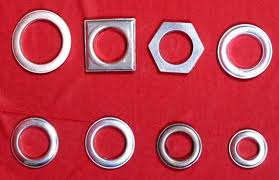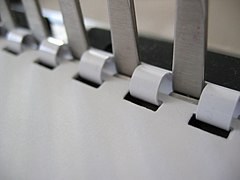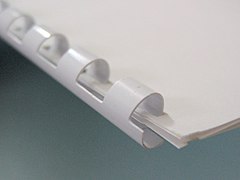
A book is a medium for recording information in the form of writing or images, typically composed of many pages bound together and protected by a cover. It can also be a handwritten or printed work of fiction or nonfiction, usually on sheets of paper fastened or bound together within covers. The technical term for this physical arrangement is codex. In the history of hand-held physical supports for extended written compositions or records, the codex replaces its predecessor, the scroll. A single sheet in a codex is a leaf and each side of a leaf is a page.

Paper size standards govern the size of sheets of paper used as writing paper, stationery, cards, and for some printed documents.

An MFP, multi-functional, all-in-one (AIO), or multi-function device (MFD), is an office machine which incorporates the functionality of multiple devices in one, so as to have a smaller footprint in a home or small business setting, or to provide centralized document management/distribution/production in a large-office setting. A typical MFP may act as a combination of some or all of the following devices: email, fax, photocopier, printer, scanner.

A perforation is a small hole in a thin material or web. There is usually more than one perforation in an organized fashion, where all of the holes collectively are called a perforation. The process of creating perforations is called perforating, which involves removing bits of the workpiece with a tool. Old-fashioned lick-and-stick postage stamps are perforated. When a tool makes small cuts in the material it's called 'rouletting', because that tool often resembles a roulette wheel, with blades around the edge. Raffle tickets are a good example of rouletting.

A grommet is a ring or edge strip inserted into a hole through thin material, typically a sheet of textile fabric, sheet metal or composite of carbon fiber, wood or honeycomb. Grommets are generally flared or collared on each side to keep them in place, and are often made of metal, plastic, or rubber. They may be used to prevent tearing or abrasion of the pierced material or protection from abrasion of the insulation on the wire, cable, line being routed through the penetration, and to cover sharp edges of the piercing, or all of the above.

A hole punch, also known as hole puncher, or paper puncher, is an office tool that is used to create holes in sheets of paper, often for the purpose of collecting the sheets in a binder or folder. A hole punch can also refer to similar tools for other materials, such as leather, cloth, or plastic or metal sheets.

Ring binders are large folders that contain file folders or hole punched papers. These binders come in various sizes and can accommodate an array of paper sizes. These are held in the binder by circular or D-shaped retainers, onto which the contents are threaded. In North America, the rings themselves come in a variety of sizes, including 0.5, 1, 1.5, and 2 inches, though other sizes are also available. The rings may be secured by lever arch mechanisms or other securing systems, or may be spring-loaded. The binders themselves are typically made from plastic with metal rings. Early designs were patented during the early 1890s to the early 1900s.
A loose leaf is a piece of paper of any kind that is not bound in place, or available on a continuous roll, and may be punched and organized as ring-bound or disc-bound. Loose leaf paper may be sold as free sheets, or made up into notepads, where perforations or glue allow them to be removed easily. "Leaf" in many languages refers to a sheet or page of paper, as in Folio, as in feuille de papier (French), hoja de papel (Spanish), foglio di carta (Italian), and ルーズリーフ.

Book design is the art of incorporating the content, style, format, design, and sequence of the various components and elements of a book into a coherent unit. In the words of renowned typographer Jan Tschichold (1902–1974), book design, "though largely forgotten today, [relies upon] methods and rules upon which it is impossible to improve, [and which] have been developed over centuries. To produce perfect books, these rules have to be brought back to life and applied". Richard Hendel describes book design as "an arcane subject", and refers to the need for a context to understand what that means.

Microforms are scaled-down reproductions of documents, typically either films or paper, made for the purposes of transmission, storage, reading, and printing. Microform images are commonly reduced to about 4% or 1⁄25 of the original document size. For special purposes, greater optical reductions may be used.

Traditional Chinese bookbinding, also called stitched binding, is the method of bookbinding that the Chinese, Koreans, Japanese, and Vietnamese used before adopting the modern codex form.
Paper drilling is a technique used in trade binderies for providing large quantities of paper with round holes. The paper can be processed as loose leaves and in brochures. The holes usually serve for storage (filing), sometimes for decorative purposes by eccentric individuals.
VeloBind is a type of book binding often offered at copy and print shops. Velobinding involves punching several small holes along the edge of an unbound book. A strip of plastic with rigid tines is inserted into the holes from the top of the book, and a strip with corresponding holes is placed on the back with the tines protruding through. The book is then placed in a machine that holds the book tightly while the excess length of the tines is cut and the tips melted to seal the bind. The term "VeloBind" is a trademark of the General Binding Corporation, but is regularly used generically to refer to this process, though strip binding is also sometimes used.

Book scanning or book digitization is the process of converting physical books and magazines into digital media such as images, electronic text, or electronic books (e-books) by using an image scanner. Large scale book scanning projects have made many books available online.
Grammage and basis weight, in the pulp and paper industry, are the area density of a paper product, that is, its mass per unit of area. Two ways of expressing grammage are commonly used:

Continuous stationery (UK) or continuous form paper (US) is paper which is designed for use with dot-matrix and line printers with appropriate paper-feed mechanisms. Other names include fan-fold paper, sprocket-feed paper, burst paper, lineflow, tractor-feed paper, and pin-feed paper. It can be single-ply or multi-ply, often described as multipart stationery or forms. Continuous stationery is often used when the final print medium is less critical in terms of the appearance at the edges, and when continuously connected individual sheets are not inconvenient for the application. Individual sheets can be separated at the perforation, and sheets also have edges with punched holes, which also can be removed at the perforation.

Wire binding is a popular commercial book binding method, and is known by various names, including double loop wire, double-o, ring wire, twin loop wire, wire comb, wire-o, wirebind and wiro. With this binding method, users insert their punched pages onto a "C" shaped spine, and then use a wire closer to squeeze the spine until it is round. Documents that are bound with wire binding will open completely flat on a desk, and allow for 360 degree rotation of bound pages, without the side protrusion produced by spiral binding.

Coil binding, also known as spiral binding, is a commonly used book binding style for documents. This binding style is known by a number of names including spiral coil, color coil, colorcoil, ez-coil, plastic coil, spiral binding, coilbind.

Bookbinding is the process of building a book, usually in codex format, from an ordered stack of paper sheets with one's hands and tools, or in modern publishing, by automated processes. Firstly, one binds the sheets of papers along an edge with a thick needle and strong thread. One can also use loose-leaf rings, binding posts, twin-loop spine coils, plastic spiral coils, and plastic spine combs, but they last for a shorter time. Next, one encloses the bound stack of paper in a cover. Finally, one places an attractive cover onto the boards, and features the publisher's information and artistic decorations.

A punched pocket, plastic wallet, poly pocket, slippery fish, sheet protector, plastic sleeves, or sometimes perforated document bag, is a flat, slit plastic bag with a perforated edge used to hold paper documents.




















